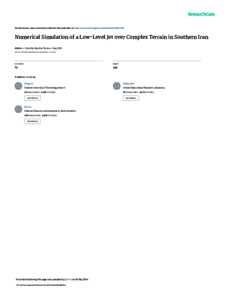Document
Numerical simulation of a low-level jet over complex terrain in Southern Iran.
Identifier
DOI: 10.1175/1520-0493(2000)128<1309:NSOALL>2.0.CO;2
Source
Monthly Weather Review. v. 128, 5, p. 1309-1327
Contributors
Country
United States.
City
Massachusetts
Publisher
American Meteorological Society.
Gregorian
2001-05-01
Language
English
English abstract
The Lut Desert of Iran is an elongated valley oriented north-northwest to south-southeast. The valley descends southward to the Jaz Murian dry lake through a pass. The Navy's Coupled Ocean-Atmosphere Mesoscale Prediction System is used to study a northerly low-level jet in the valley and across the dry lake. The dynamics of the jet are investigated with force balance and Froude numbers to determine the contribution of various mechanisms to the jet formation and maintenance. The jet is initiated as a channeled gap flow in the convergent topography of the Lut valley by the valley-parallel pressure gradients generated by the large-scale processes and by the presence of cold air over the valley's sloping terrain. The pressure gradient is mainly counteracted by the frictional force. The imbalance between them controls the intensity and persistence of the jet in the valley. Farther south, the jet evolves into a downslope flow resembling a hydraulic jump on the steep slope of the dry lake. A transition of subcritical situation to supercritical faster flow is found at the mountain crest between the Lut valley and dry lake. The depth of stably stratified cold layer, the static stability of upstream inversion, and magnitude of upstream winds all determine the jet configuration over the dry lake. The lee troughing over the Gulf of Oman and the Persian Gulf, as the large-scale inland flow crosses the coastal mountains, supports this low-level jet through the increased along-jet pressure gradient. The jet is also influenced by diurnal forcing. being strong at night and weak during daytime.
ISSN
0027-0644
Category
Journal articles

